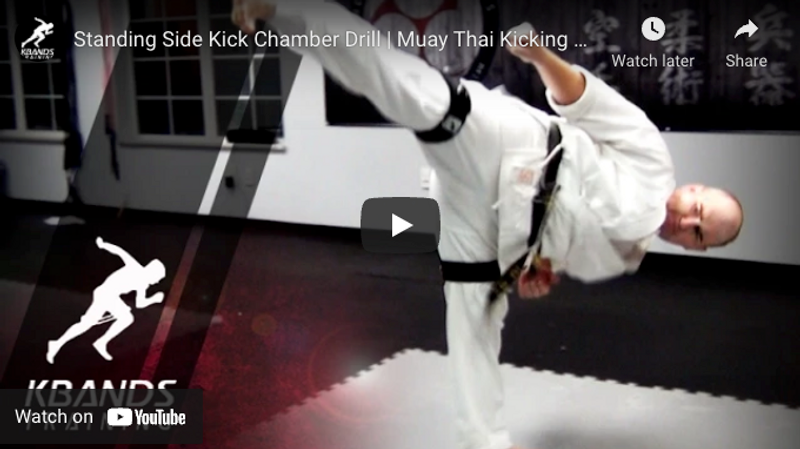Muay Thai Training: Resisted Side Chamber Kicks
This video demonstrates one of the most essential moves in Muay Thai training and a fundamental element of Muay Thai kickboxing: the chambered side kick. In fact, Muay Thai isn’t the only art form that relies on this maneuver; many kick-focused martial arts involve a form of the chambered side kick and though the name attached to the kick may vary, the basic move remains similar across a variety of forms and styles. This kick is very versatile, which means that it’s delivered from a stable stance and can be executed in small spaces and tight positions. The chambered side kick can be incorporated into a wide range of combination kicks, and it can be mastered by Muay Thai practitioners at every level.
The power of this kick comes from the core, or from the set of four muscle groups located in the body’s center of gravity, the area at the base of the torso between the hip bones. These four muscle groups work in powerful cooperation, and when all four are strong, conditioned, and flexible, they collectively provide strength and stability to muscle groups in the arms, legs, shoulders, and upper back. A strong core provides a stable anchor for all movement that takes place in the limbs, so by conditioning and training the core, athletes provide the groundwork for more effective and efficient training in every other area of the body.
The move demonstrated in this video provides a double benefit: It strengthens and tightens the core, and it supports Muay Thai training at every level by allowing athletes to practice a fundamental kick and work on their technique and muscle memory. The move requires very little equipment—Just a safe floor surface and a set of Kbands resistance training bands for each participant.
Muay Thai Training: Setting up The Chambered Side Kick Drill
Before the Chambered Side Kick Drill Begins, athletes will need to warm up and stretch appropriately, and then they’ll need to attach the Kbands. The Velcro straps can be attached snugly around the upper legs with the metal rings on the outside, and then the resistance bands can be clipped to the rings with the long band in front and the shorter band in the back. Athletes can find a place on the floor with enough space to execute a forward kicking motion and move several yards to the left and right.
Muay Thai Training: Executing the Chambered Side Kick Drill
Athletes can begin the Chambered Side Kick Drill by adopting the basic straddle stance. The body should be bladed to the side, with the right foot planted forward toward the center of the room and the left foot back toward the wall. The knees should be bent and the center of gravity should be slightly lowered. The arms should be up and engaged, and the eyes should be raised and focused toward the center of the room.
As the Muay Thai Chambered Side Kick Drill begins, athletes will raise the left foot and bring it forward (toward the center of the room). The left foot will be planted behind the right foot, and the right foot will rise into the air to execute the kick. Athletes will bring the right knee in toward the chest in order to “chamber” the kick, or generate the force and leverage behind the impact. The closer the knee comes to the chest, and the tighter the bend, the more power be loaded into the kick. Once the knee is bent and the kick is chambered, the eyes will focus on the target, and the foot will come straight forward for impact. As always, athletes should remember to deliver the kick with the heel, not the toes or ball of the foot. The heel will come straight forward, the kick will land, and the knee will bend toward the chest again before the foot is planted back on the ground.
As the kick is released, the resistance of the Kbands will tend to push the body to the left or the right. In order to get the most out of the Chambered Side Kick Drill, athletes will need to actively resist this pressure and work hard to stay centered and keep the kick motion straight. This will increase the tension on the muscles of the core, and with multiple repetitions, these muscles will become responsive, tight, and conditioned. The knee will straighten with greater speed and force, and the impact of the kick will land with greater levels of power and control.
Muay Thai Chambered Side Kick Drill: Final Notes
The Chambered Side Kick Drill is very effective and also very simple, so it can easily be incorporated in the beginning, middle or end of any standard Muay Thai training routine. The entire drill should include ten repetitions of the kick from the right side, followed by ten kicks from the left. Ideally, each kick should take place under the careful observation of a trainer or coach who can correct small problems with technique before they become ingrained habits. Both athletes and Muay Thai coaches should keep in mind that each repletion develops not only strength and condition, but also coordination and muscle memory.
After completing ten rounds of the Chambered Side Kick on the left and then the right, athletes can visit KbandsTraining.com and explore the martial arts training section of the site for a variety of similar drills.

